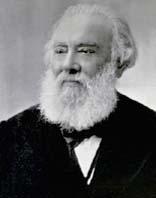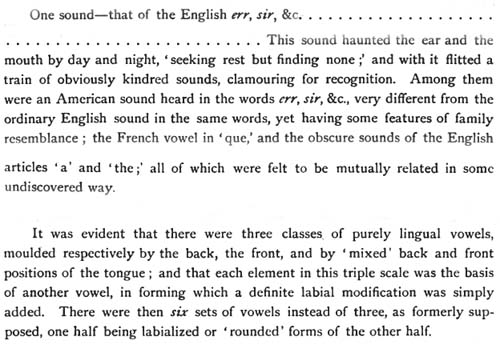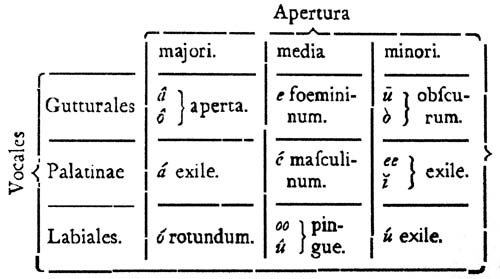How it all started:
The Bell vowel model
This topic continues at:
The ancient throat-tongue-lip model
The Bell vowel model: its acoustic weaknesses
  |
Alexander Melville Bell’s model for vowel articulation will see its 150th anniversary in 2017. The latest date in Visible Speech, where the model was published, was August 1867, so let’s have the birthday celebration on 1 September. Will it be a wake, or will it start a new golden 150 year era? |
From pages 15-16:
 |
On pp. 15-16, Bell recounts how, after much puzzling over the articulation of the vowel of sir, he got the idea of the the tongue not only being raised to the hard or soft palate but also medially between them. This was the birth of the tongue arching model, as Oscar Russell called it in 1928 (The Vowel) , and with it the innovation of a class of vowels with alleged central tongue position. Bell’s unique conceptual break with the past was to view the mouth as a continuous space where the tongue would move freely to create an infinity of new vowels, analogous to longitude and latitude. Initially, he divided the mouth into nine cardinal regions: front, mixed (i.e. central) and back (for tongue positions along the hard and soft palates) vs. high, mid and low (distance from the palate). Each could be subdivided into nine smaller regions by inner vs outer shifts (retracted vs advanced) and higher vs lower shifts (raised vs lowered). All of these were either primary or wide (what we now call tense or lax).
Bell’s revolutionary innovations were thus (1) the concept of central tongue positions between front and back, (2) the concept of tongue height, and (3) the concept of spectrally significant small shifts of tongue position in any direction.
Hitherto, vowel production had been conceptualized as a tree: a tongue (or palatal) branch for [i e]-like vowels, and a lip (or labiovelar) branch for [u o]-like vowels, splitting from a throat node for [a]. Intervals along the branches marked mouth (or jaw) openings. This throat-tongue-lip model was inherited from the times of Panini in ancient India. Through Buddhism and cultural contact with Islam, sanskrit grammar and its associated vowel model spread east to China and Japan and west to Arabia, before reaching Greece and Rome and the rest of Europe. Along the way, a tongue-lip (or mixed) branch was added for [y-ø]-like vowels (combining palatal tongue position with lip rounding). Bell had himself followed the tradition of his time in 1849 and included the ancient model in what was to become a bestseller with posthumous editions continuing well into the 20th century (Principles of Speech and Vocal Physiology).
The final addition to the ancient model was a branch for unrounded counterparts of [u o], i.e. tongue position of [u o] combined with lip position of [i-e]. The velar character of this tongue position wasn’t always stated explicitly, the basic [u o]-like branch usually just being labelled the lip branch. But it has to be implicit once the tongue+lip [y ø]-like vowels were included, to avoid ambiguity. These extra branches were known as mixed, recognizing their combination of tongue from one basic branch and lips from the other basic branch. Bell claimed these lip combinations as a discovery in Visible Speech, but the rounded front front vowels had been recognized since the middle ages, and Lepsius had already described the unrounded back vowels in 1855 and 1861 (Das Allgemeine Linguistische Alphabet, Berlin; Ueber die Arabischen Sprachlaute und deren Umschrift und über den harten i Vocal in den Tartarischen, Abh Königl Ak Wiss zu Berlin 7-152).
Propagated by Ellis, Jespersen, Sievers, Storm and Sweet, Bell’s new vowel model was rapidly adopted by the new movements that dominated the latter part of the 19th century – the neogrammarians, the language teaching reformers and the IPA.
|
|
John Wallis’s presentation of the ancient throat-tongue-lip model
|
After the general adoption of the Bell model, they started reinterpreting the trees of the ancient model as triangles. This is not trivial – a tree expresses relations between its branches and nodes, whereas the surfaces encompassed by the branches, or the angles between the branches at the nodes, have no meaning. But a triangle, in contrast, encloses a continuous plane and locations within it are defined in geometrical terms. The Bell model was forced onto its conceptually different rival, creating the impression that these earlier authors hadn’t quite managed to figure out what Bell finally discovered. A good instance of this was Michaelis (Über die Anordnung die Vokale, Archiv für das Studium der Neueren Sprachen und Literaturen, 65 403-460, 1881), who is so often quoted as an authority on the history of vowel classification. But he was also pushing a biased consolidation of the Bell model to German contemporaries who weren’t yet whole-heartedly converted, and supporting Sievers whose newly revised phonetics manual eventually established the Bell model in Germany. For example, Michaelis welcomed John Wallis’s account (1653) as a major step forward, on the strength of its being presented in a square format like Bell’s. This is simply confusing iconographic form with conceptual content. Wallis’s account continued the parameters of the ancient throat-tongue-lip model without modification – three places of location (gutteral, palatal, labial) and three degrees of opening (explicitly jaw opening – apertura faucium), presenting the features of the ancient throat-tongue-lip model in the form of a matrix. Wallis’s ancient account and Bell’s new model have nothing in common. All that remains of the ancient model in Bell’s model is that any lip activity can be freely combined with any internal configuration. Bell rejected his predecessors as unscientific, his model was a unique and imaginative invention that had no precursors.
Bell wove his new vowel model into a comprehensive whole by linking it to the then traditional single cavity theory. He said there was a configurative aperture above the tongue that could be located anywhere along the palate; advancing or retracting the tongue would shorten or lengthen the bucchal cavity, changing its resonance and sound; lowering or raising the tongue would alter the dimension of the configurative aperture, modifying the cavity resonance and vowel sound again. Unfortunately Hemholtz had already demonstrated at least two vowel formants (Die Lehre den Tonempfindungen, 1863), and Rayleigh was working out the principles of acoustic theory (The Theory of Sound, 2 vols, 1877). But the single cavity theory wasn’t finally discarded by phoneticians until well into the 20th century (and it survived in a bestseller like Daniel Jones’ Outline from 1918 right through to the final edition in 1967). But the notion of an individual cavity as a home for a resonance continued, Helmholtz’s two formants eventually being explained as a mouth formant and a throat formant, while Bell’s configurative aperture was reinterpreted as the significant boundary between the two resonance chambers. Helmholtz had been convinced already in 1863 that there were more than two formants and once they were confirmed it became clear that there aren’t enough single cavities for each formant to have its own. The knell was already sounding.
Much of Bell’s original terminology has been renamed since 1867, but front/back and high/low are still in use. Bell’s mixed was changed to central by Daniel Jones. Bell’s primary/wide became Sweet’s narrow/wide, and is now tense/lax. Inner/outer is now advanced/retracted. Higher/lower is now often raised/lowered. These were straightforward name changes with no conceptual significance. But there were also theoretical disputes, such as questioning the basis for primary/wide and seeing it simply as a special case of higher/lower, so that we now have two subclasses of the Bell model, one with four degrees of height but no tense/lax and one with Bell’s original three degrees of height and tense/lax. Daniel Jones chose a different domain for his cardinal vowels, scales of vowel timbre from [i] to [u], [i] to [a] etc. Nevertheless, he still chose physiological labels, keeping Bell’s front/back but substituting close/open for high/low (focusing directly on the dimension of Bell’s configurative aperture), and stated that equal shifts of timbre corresponded to equal shifts of tongue position. Bell’s model is still there at the heart of Jones’ cardinal vowel scheme, although he was one of these who preferred four degrees of height (closeness), subsuming tense/lax with raised/lowered.
Top

